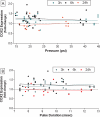Altered gene expression in cultured microglia in response to simulated blast overpressure: possible role of pulse duration
- PMID: 22698585
- PMCID: PMC3396767
- DOI: 10.1016/j.neulet.2012.06.012
Altered gene expression in cultured microglia in response to simulated blast overpressure: possible role of pulse duration
Abstract
Blast overpressure has long been known to cause barotrauma to air-filled organs such as lung and middle ear. However, experience in Iraq and Afghanistan is revealing that individuals exposed to explosive munitions can also suffer traumatic brain injury (TBI) even in the absence of obvious external injury. The interaction of a blast shock wave with the brain in the intact cranial vault is extremely complex making it difficult to conclude that a blast wave interacts in a direct manner with the brain to cause injury. In an attempt to "isolate" the shock wave and test its primary effects on cells, we exposed cultured microglia to simulated blast overpressure in a barochamber. Overpressures ranging from 15 to 45 psi did not change microglial Cox-2 levels or TNF-α secretion nor did they cause cell damage. Microarray analysis revealed increases in expression of a number of microglial genes relating to immune function and inflammatory responses to include Saa3, Irg1, Fas and CxCl10. All changes in gene expression were dependent on pulse duration and were independent of pressure. These results indicate that microglia are mildly activated by blast overpressure and uncover a heretofore undocumented role for pulse duration in this process.
Published by Elsevier Ireland Ltd.
Figures


Similar articles
-
Shock Wave Physics as Related to Primary Non-Impact Blast-Induced Traumatic Brain Injury.Mil Med. 2021 Jan 25;186(Suppl 1):601-609. doi: 10.1093/milmed/usaa290. Mil Med. 2021. PMID: 33499439
-
Intracranial venous injury, thrombosis and repair as hallmarks of mild blast traumatic brain injury in rats: Lessons from histological and immunohistochemical studies of decalcified sectioned heads and correlative microarray analysis.J Neurosci Methods. 2016 Oct 15;272:56-68. doi: 10.1016/j.jneumeth.2016.02.001. Epub 2016 Feb 6. J Neurosci Methods. 2016. PMID: 26861907
-
Neuroinflammation in primary blast neurotrauma: Time course and prevention by torso shielding.Exp Neurol. 2016 Mar;277:268-274. doi: 10.1016/j.expneurol.2016.01.010. Epub 2016 Jan 16. Exp Neurol. 2016. PMID: 26784004
-
Blast Injuries and Blast-Induced Neurotrauma: Overview of Pathophysiology and Experimental Knowledge Models and Findings.In: Kobeissy FH, editor. Brain Neurotrauma: Molecular, Neuropsychological, and Rehabilitation Aspects. Boca Raton (FL): CRC Press/Taylor & Francis; 2015. Chapter 45. In: Kobeissy FH, editor. Brain Neurotrauma: Molecular, Neuropsychological, and Rehabilitation Aspects. Boca Raton (FL): CRC Press/Taylor & Francis; 2015. Chapter 45. PMID: 26269895 Free Books & Documents. Review.
-
Physical correlates of eardrum rupture.Ann Otol Rhinol Laryngol Suppl. 1989 May;140:35-41. doi: 10.1177/00034894890980s507. Ann Otol Rhinol Laryngol Suppl. 1989. PMID: 2497697 Review.
Cited by
-
Demethylation of ITGAV accelerates osteogenic differentiation in a blast-induced heterotopic ossification in vitro cell culture model.Bone. 2018 Dec;117:149-160. doi: 10.1016/j.bone.2018.09.008. Epub 2018 Sep 13. Bone. 2018. PMID: 30219480 Free PMC article.
-
ACOD1 in immunometabolism and disease.Cell Mol Immunol. 2020 Aug;17(8):822-833. doi: 10.1038/s41423-020-0489-5. Epub 2020 Jun 29. Cell Mol Immunol. 2020. PMID: 32601305 Free PMC article. Review.
-
Evaluating Primary Blast Effects In Vitro.J Vis Exp. 2017 Sep 18;(127):55618. doi: 10.3791/55618. J Vis Exp. 2017. PMID: 28994788 Free PMC article.
-
A Novel In Vitro Platform Development in the Lab for Modeling Blast Injury to Microglia.Front Bioeng Biotechnol. 2022 Jul 12;10:883545. doi: 10.3389/fbioe.2022.883545. eCollection 2022. Front Bioeng Biotechnol. 2022. PMID: 35903797 Free PMC article.
-
Neuronal Injury and Glial Changes Are Hallmarks of Open Field Blast Exposure in Swine Frontal Lobe.PLoS One. 2017 Jan 20;12(1):e0169239. doi: 10.1371/journal.pone.0169239. eCollection 2017. PLoS One. 2017. PMID: 28107370 Free PMC article.
References
-
- Arbogast KB, Margulies SS. Material characterization of the brainstem from oscillatory shear tests. J. Biomech. 1998;31:801–807. - PubMed
-
- Arun P, Spadaro J, John J, Gharavi RB, Bentley TB, Nambiar MP. Studies on blast traumatic brain injury using in-vitro model with shock tube. Neuroreport. 2011;22:379–384. - PubMed
-
- Bauman RA, Ling G, Tong L, Januszkiewicz A, Agoston D, Delanerolle N, Kim Y, Ritzel D, Bell R, Ecklund J, Armonda R, Bandak F, Parks S. An introductory characterization of a combat-casualty-care relevant swine model of closed head injury resulting from exposure to explosive blast. J. Neurotrauma. 2009;26:841–860. - PubMed
-
- Belanger HG, Uomoto JM, Vanderploeg RD. The Veterans Health Administration's (VHA's) Polytrauma System of Care for mild traumatic brain injury: costs, benefits, and controversies. J. Head Trauma Rehabil. 2009;24:4–13. - PubMed
-
- Block ML, Zecca L, Hong JS. Microglia-mediated neurotoxicity: uncovering the molecular mechanisms. Nat. Rev. Neurosci. 2007;8:57–69. - PubMed
Publication types
MeSH terms
Grants and funding
LinkOut - more resources
Full Text Sources
Research Materials
Miscellaneous

